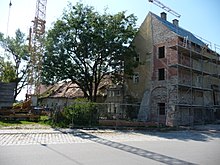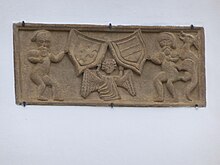Aholming Castle
The Aholming Castle (sometimes lock Isarau called) is located in the Lower Bavarian community Aholming in the district of Deggendorf (Isar Straße 41).
history
The earliest named representative of the Aholminger family is Walchoun de Auhalmingen , who is mentioned around 1112 in Passau traditions or as a witness for the St. Nikola monastery . These are ministerials of the Passau bishopric, who were supposed to secure the western possessions of the diocese here. Be specified or Sigeboto de Ohalmingen (ca. 1145), Rapoto de Ouhalmingen (about 1155) and a Siboto de Oulhalmingen (ca. 1170). Other members of this family later seal for Count Albert IV von Bogen , such as Henricus de Ahalming (1225, 1232) and Henricus de Acholmingen (1233). In a note from the monastery of St. Nikolas, a Christianus Chunradus de Ahalming is referred to as a dominus , an indication of an elevated position in this family. The last of this family is a son of Heinrich des Ortlein (1312).
The Passau bishopric established a Hofmark here very early on ; the hofmarchia Ahalminge is in a Urbar called the 13th century. In the middle of the 13th century, Aholming came into the area of Burkhard von Weiher (son of Count Konrad I von Moosburg, since 1246 guardian of Count Albert III von Hals ). However, this was soon replaced by the Wittelsbach family . The Counts of Hals had usurped the bailiff over the diocese of Passau and the monastery of St. Nikola, so that after the end of this family, Aholming had become part of the Wittelsbach Bavaria. Aholming appears in the 2nd Duke's Surbar under the Hengersberg court . The Veste Aholming continued to exist independently of the Bailiwick and was owned by Aholminger Ministeriale.
In 1318 the Bavarian dukes of Aholming had to pawn the brothers Hartwig and Altmann zum Degenberg and their nephews Eberwein. When the Degenberian estates of Aholming were divided (1336), the brothers Hartwig and Altmann acquired ownership and fiefdom here. In 1342, at the request of Emperor Ludwig the Bavarian , the two brothers sold goods and Gülten from Aholming to the Passau landlord Ludwig auf dem Stein, so that the pledge would be reduced. As a thank you, Emperor Ludwig gave the landlord, his wife Agnes and his daughter Katharina the bailiwick of Aholming and Penzling for life, including the castle in Aholming. After this Heinrich Tuschl von Söldenau is the owner. In 1363 he sold everything to the Straubing Vitztum Ulrich Kamerauer zum Haidstein. The Chamerauer remained the owners of Aholming until 1413.
In 1413 Heinrich Nothaft , whose daughter Barbara had been married to Peter Kamerauer in 1403, bought the property as free property from his son-in-law. The Nothafts remained the owners of Aholming for 300 years. Aholming Castle was given to the latter by Heinrich's three sons, Haimeran, Albrecht and Heinrich. He had numerous conversions and new buildings carried out in Aholming. Pastor Rettinger writes about this in his family chronicle : “ This Mr. Hainrich has paused at his name as Zu Eckhmüll vnnd sunderlich hie Zu Ahelming, he has opened the vestibule at the closed Zu Iseraw vmb vnnd vmb, to which the lock vmb vnnd vmb, Alß Zwey better built up and raised. "
In 1493 Jörg Nothaft zu Aholming received the local ducal fiefs (Aholming Castle with neck dish , stick and gallows and other accessories). In 1514, the brothers Kaspar, Hans, Albrecht and Bernhard were found to be in distress here. Bernhard Notthracht was involved in the Landshut War of Succession in 1504 in the entourage of Duke Albrecht . The Aholmingen property suffered great damage, he stayed at Deggendorf for a time "because of weakness" and finally became a carer in Hengersberg († 1517). Kaspar Nothaft, the eldest, received the ducal fief after the death of his cousin Jörg in 1512. After his death († 1521) he was followed by Hans Nothaft and after his death († 1529) by Christoff Joachim Nothaft and in 1548 Haimeran Nothaft. In 1553 the owners of the Aholming estate received the right to brew beer and hold fairs from Emperor Charles V.
In 1557 the rule of Aholming was divided into three parts, the parts being awarded by Bishop Wolfgang to Wolf Dietrich von Maxlrain and the Haimeram and Kaspar Nothaft. The ducal fiefs were always awarded to the eldest of the Nothafts, for example to Hans Heinrich in 1570, to Kaspar in 1581, to Hans Bernhard in 1601 and in 1612 on behalf of the widow Barbara Nothaft for her son Wilhelm (cousin of the deceased Hans Bernhard) to Ferdinand Khuen von Belasy . The part of the Aholmingen legacy that was due to Hans Bernhard went to his son Hans Albrecht, and part to the Straubing judge Hans Sigmund Nothaft. In 1636 Franz Ignatz Nothaft, son of the late Wilhelm, received the fiefs over the neck court, stick and gallows as well as the wild bans . In 1637 there were five owners of the Aholming estate: Wilhelm von Maxlrain, the heirs of Wolfdietrich von Maxlrain, the heirs of Wilhelm Nothaft (especially Franz Ignatz), Ortlieb Freiherr von Pötting and the widow of Hans Sigmund Nothaft. Ortlieb von Pötting was followed by his son Sebastian von Pötting in 1655 . In 1646, Johann Heinrich and Franz Ignatz (owners of the Neck Court from 1652) are attested from the family in need. Johann Heinrich Nothaft followed in 1660, followed by his son Wolfheinrich in 1666, who in 1676 left his fiefdom to his brother Georg Heinrich Nothaft († 1703). He had Aholming Castle partly renovated, partly rebuilt and set up as a domicile.
The barons of Gumppenberg zu Pöttmes had also received part of Aholming through inheritance . After Adam Heinrich Gumppenberg's death in 1670, his share became free and the Passau Monastery awarded it to Count Johann Ferdinand Albrecht von Preysing . In 1672 there were three royal lords: Johann Heinrich Freiherr von Haslang and his wife Maria Anna Siguna Countess von Törring , née von Maxlrain, Count Heinrich Nothaft and Johann Ferdinand Albrecht Count Preysing. Heinrich Nothaft bought the Maxlrain share and the Counts Preysind continued to have the so-called Moosischen rule title on Aholming. The line of emergency was continued in 1705 by Sebastian Heinrich. After his death († 1710), Emperor Joseph I gave Johann Heinrich Nothaft the fief. He died in 1734 as the last of his family. The freed fiefdom was then awarded by Elector Maximilian Joseph to Johann Franz de Paula Graf von Preysing and his male heirs. In 1758 Johann Kaspar Graf von Preysing zu Moos received the fief and after his death († 1770) his son of the same name. He had the castle demolished in 1791 except for the portal building and the farmyard. Under the Preysings, Aholming is referred to as Hofmark, although the title Grafschaft Aholming was at times common due to the jurisdiction of the neck .
Penzling and Tabertshausen also belonged to the Aholming rule . The latter was the seat of a separate ministerial dynasty in the high Middle Ages . Of these, a Luitgotz de Tabrechshusen (1076), a Werinhart de Tagebdreheshusen (1112) and an Albrecht von Tabertshausen (1130–1165) are mentioned in documents. The way in which Tabertshausen came to the emergency is unclear.
1804 is proven as the owner of the Hofmark Aholming Count Johann Kaspar Reichsgraf von Preysing. In 1838 Aholming came to the Osterhofen Regional Court , formerly the Otzing Office in the Natternberg Court. In 1808 Aholming belonged to the Deggendorf tax district.
Aholming Castle then and now
As can be seen in the engraving by Michael Wening from 1721, Aholming Castle was a mighty complex. A three-storey house with a tent roof had a tower to the east, which was covered with an onion dome. In front of it was a flat-roofed gate tower that was accessible via a bridge. A garden can be seen next to the castle. To the west of this you can see the castle chapel with an onion dome, which was connected to the other buildings by a wall. Also to the west is a four-wing farm yard that can be reached via gateways. The palace complex stood east of today's outer bailey on a square gravel island with a side length of approx. 25 m and was surrounded by an approx. 20 m wide moat. This palace building was partly renovated and partly rebuilt by Count Georg Heinrich Notthracht in the second half of the 17th century. Johann Kaspar Graf von Preysing the Elder J. had the castle demolished in 1791. The stone material is said to have been used to build the brewery in Moos . The castle building represented by Wening is now cut through by the local road leading to Aholming.
The late Gothic portal building (a three-storey gable building) and the one-storey farm yard with gable roofs (18th and 19th centuries) have been preserved. A coat of arms on the portal of the castle reminds of Count Georg Heinrich VI's lively building activity. Notthaids and his first wife Margaretha, born Countess von Ortenburg . As a shield holder, this coat of arms shows a winged angel in the middle and a wild man on both sides, with the wild man who supports the emergency shield being attacked by a mythical animal. The original stone was removed in 2008 by Count Arco-Zinneberg and shipped to Moos Castle. The current owner of the castle had a replica made and attached to Aholming Castle.
The chapel next to it is the former St. Ulrich castle church.
As has been documented, in 2005 an application was made to the Aholming City Council to take measures to preserve Aholming Castle. The owner at the time, Riprand Graf von und zu Arco- Zinneberg from Moos , who was no longer used for building the palace, applied for the listed palace building to be razed to the ground. However, the Aholmingen municipal council did not approve this project. Citizens who took the initiative also resisted this request. Due to a variety of measures, the castle was bought by Ludwig Fischer as an investor and has since been renovated.
literature
- Wolfgang Freundorfer: Straubing. Regional court, Rentkastenamt and city (pp. 144–154). (= Historical Atlas of Bavaria, part of Old Bavaria, series I, issue 32). Commission for Bavarian History, Verlag Michael Lassleben, Munich 1974, ISBN 3-7696-9879-7 ( online ).
Individual evidence
- ↑ The emergency at Aholming
- ^ Aholming Castle
- ^ Report in the Osterhofener Zeitung from November 23, 2013
Web links
- Entry on Isarau Castle (Aholming) in the private database "Alle Burgen".
- The emergency on Aholming
Coordinates: 48 ° 44 ′ 26.5 " N , 12 ° 54 ′ 30.4" E





